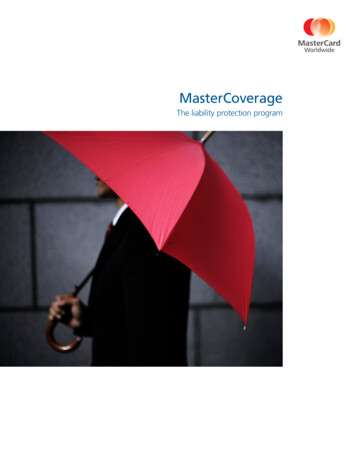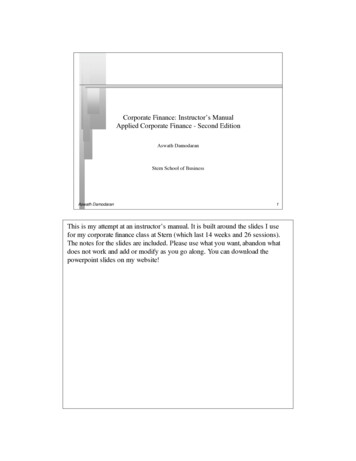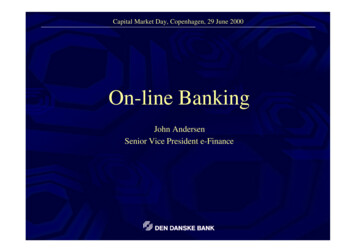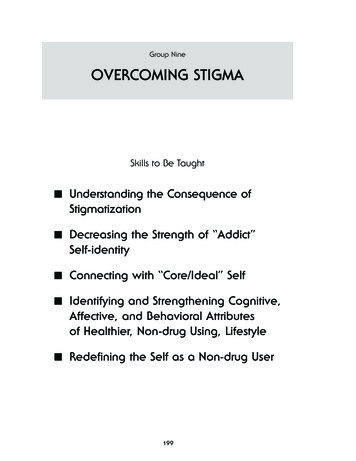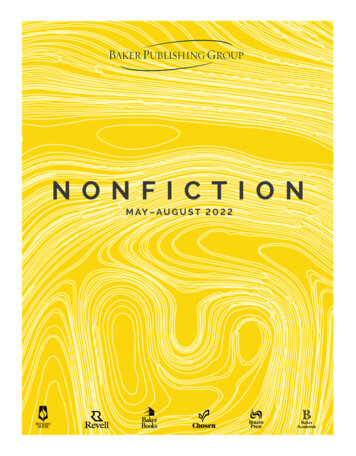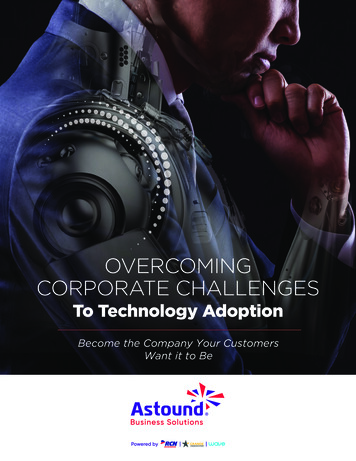
Transcription
OVERCOMINGCORPORATE CHALLENGESTo Technology AdoptionBecome the Company Your CustomersWant it to Be
EXECUTIVE SUMMARYEvery organization faces challenges when implementing technologies that will change the status quo.There are cultural challenges that discourage stakeholders from taking risks and there are proceduraland workflow challenges that lead employees to question the value of a project. There are barriers totechnology adoption that must be broken and mindsets that must be changed in order to become thecompany your customers want it to be.In an effort to inform, educate and share knowledge to help CIOs identify and overcome these challenges,Astound has been sponsoring invitation-only networking dinners in our coremarkets entitled The Future of IT.Sanjog Aul, Founder of CIO Talk Network (CTN) and author of the book TheTricycle Way, moderates these dynamic, informative discussions among localCIOs about the trends, challenges and changes facing the enterprises todayas they embark on their respective digital journeys.This white paper captures the highlights of some of the nuggets the CIOsshared including most pressing issues they have to overcome, as well asseveral action items they are implementing to meet these challenges fora successful digital transformation. These topics by no means representthe scope of the discussions, and this summary only scratches the surfaceof these free-flowing exchanges. We invite you to participate firsthand at thenext Networking CIO Dinner in your city to take a deeper dive into The Future of IT.Sanjog Aul, pictured here, at an event supported by CIO Talk Network
BECOME THE COMPANY YOUR CUSTOMERS WANT IT TO BELearning, change and the evolution of best practices often come from the active exchange of ideas andexperiences among peers. Given this premise, Astound conducts a series of workshops in which CIOsdiscuss their greatest challenges to – and possible solutions for – successful technology adoption in the ageof digital transformation. Innovation exists – or is stifled – by how a company reacts to change; or on a moregranular level, how individuals within the organization respond to changes in their roles, responsibilities andprocesses. To become the company your customers want it to be – one that engenders trust and loyalty –change must be embraced at all levels. The reward is continued prosperity for the organization and fulfillingcareers for you and your IT staff.Moderated by Sanjog Aul, a thought leader in the enterprise IT world and a consultant coach to C-levelaudiences, the following is a summation of three of the most consistently raised issues among CIOattendees viewed from an organizational context: Culture challenges, Process and Workflow challenges,and Technology Adoption challenges.OVERCOMING COMPANY CULTURE CHALLENGES, AKA PEOPLE & ATTITUDESCulture challenges prevent an organization from building an atmosphere conducive to change andallowing employees to do their jobs better. Culture challenges can be the toughest to identify and solvebecause the issues are often subjective and emotional in nature. What is a problem for one employee maybe totally normal behavior for another; a solution praised by one may be unacceptable to others.CULTURE CHALLENGE #1: FEAR OF FAILUREPerhaps the biggest inhibitor of innovation and creativity in a corporate environment is fear of failure.When people are resistant to try new things, are afraid to experiment with the status quo or are reluctantto even make a suggestion when there might be a better way, that stifles change. A brainstorming sessionin which participants keep their heads down and ideas to themselves for fear of public shaming or otherrepercussions is neither productive nor comfortable. This may stem from a lack of leadership, whenmanagers are not trusting of their subordinates, or conversely, when team members feel that managementwill not be accepting of ideas outside the box.Employees may worry that if they do something wrong they will get dinged on their performance review,lose a bonus or promotion. Maybe they witnessed someone getting fired for sticking their neck out anddon’t want to be next. They are afraid of being embarrassed. So they clam up rather than speak up to try todo the right thing. Some people need external validation to build the confidence that their ideas will not berejected out of hand or ridiculed. Then there is the possibility of a bad hire; those who have low self-esteemand little value for their own input. They may be paralyzed by fear of failure to the point where inactivity andsilence in the face of a glaring mistake seems reasonable.CORRECTIVE ACTION ITEM:Eliminate embarrassment and build trust through periodicteam meetings where managers speak less and prompt theindividual members to share how was the day/week, whatexciting work did they do and if it did not work, what was thelearning. Develop a nurturing atmosphere in which all teammembers feel comfortable expressing new ideas and viewswithout repercussions or ridicule.
CULTURE CHALLENGE #2: RISK AVERSIONWhy rock the boat? Closely related to fear of failure is the concept of risk aversion. It stems from complacencyand the if it ain’t broke don’t fix it line of thinking. When people are opposed to changing a system or processbecause what we have today works fine, innovation dies. It is the first sign of a company losing its edge.Often the reason for shelving an idea is the inability of stakeholders to visualize the full value of what theproposed solution could become, what the department could become or what the company could become ifthey took the risk to do something differently.When the culture of an organization is risk-averse, it lacks the proper perception of cost versus benefit.The propensity to take a risk is reduced when the value of the benefit is not clear. If the proposed changeresults in no appreciable gain or savings, then any cost will make the initiative seem as if it will have a negativeoutcome to the stakeholder, diminishing the chances of implementation.Corrective Action Item:Sometimes people need data to justify taking a risk.Encourage thinking outside the box to promote thedevelopment of improved processes and procedures. Whenpresenting ideas to stakeholders, elevate the level of benefitand the positive ROI of the business case by speaking totangible, quantifiable benefits that outweigh the costs.CULTURE CHALLENGE #3: LACK OF TRUSTOftentimes the emergence of negative cultural patterns, such as fear of failure and risk aversion, have rootsin the same larger issue: a lack of trust. Similar to parenting, many manager-subordinate relationshipshave a mentoring component. And just like parenting, the establishment of trust works both ways. Thereneeds to be faith that when a task is delegated, it will be executed properly. Confidence builds trust.If problems arise, they can be brought to leadership’s attention and questions can be asked withoutassigning blame. Trust impacts lateral relationships as well. A lack of trust among team members can lead topoor communications, redundancy and fractured relationships that impact overall team performance. In theextreme, people may fear someone – a manager or coworker – will steal their idea and claim it as their own,so it never sees the light of day. Sometimes it’s not necessarily trust, but credibility. A person may sit on anidea because they believe management doesn’t have the will or political muscle to see it through.Employees who have a lack of trust in management fear they will be judged or lectured, so theystop volunteering information. Managers who have a lack of trust in their employees’ ability to execute aproject will sit in their ivory towers formulating plans and dole out tasks without input from staff, furtherdiminishing employee trust in management’s decisions.Corrective Action Item:We’re all in this together. Instill the notion of teamwork andthat everyone is here to help one another be successful.Your gain is our gain. My win is your win. When a teammember comes to you with an issue, be empathetic. Listen,don’t lecture, and validate the concern. When everyonebelieves someone has their back, great things happen asa team.
OVERCOMING PROCESS & WORKFLOWCHALLENGES, AKA SHOW ME THE MONEYThe company has a process in place to manufacture or assemble its product. There is a system forcommunicating with customers and how that data is handled. There are proper channels and steps throughwhich a purchase order is approved or how expense reports are submitted. These are all examples ofworkflows, and all workflows should be periodically reexamined to see which steps can be modernized,merged or eliminated to improve performance. One trap people fall into is skipping or condensing steps toincrease efficiency at the expense of quality. It’s one thing to reengineer a process to make it more efficient,but it is another to affect that change without increasing costs or impacting quality. To be able to exploitthe full value of what digital technology can bring to the table, organizations must be open to changingprocesses and workflows.PROCESS & WORKFLOW CHALLENGE #1:LACK OF INCENTIVEHave you ever asked, Why aren’t we taking a fresh look at this process to see how we can achieve betteroutcomes? The answer usually is a lack of incentive. There has to be a payoff to the change that people canget behind, or the effort will be doomed to failure – if it gets off the ground at all. People balk at investingtime and effort into workflow and process rethinking when there is no perceived benefit beyond what thepresent system offers. They’ve already got enough to do. Change for the sake of change is resisted.What’s in it for me? is the question most people ask. If the net result is producing fundamentally the sameproduct or service and the team has to alter a proven system without a reduction in hours, less stress orresponsibilities, or an increase in compensation, there is no incentive for change. People challenge theproposal when they do not see a change in outcome or a tangible benefit. When people get the most fordoing the least, inertia results.Corrective Action Item:When revisiting a workflow, sketch out a proof ofconcept and test theories on paper first to determinehow much time or effort will be saved. Perform a dryrun, making zero investment in the change until thebusiness case is proven to management. Get teammembers on board by providing specific examples ofhow their daily routines will be improved by adoptingthe change. Explore the concept of building Digital Twinsthat’s successfully used in manufacturing industry.
PROCESS & WORKFLOW CHALLENGE #2: UNWILLING/UNABLE TO GET OUT OF THE COMFORT ZONEMany companies go out of their way to create a comfortable work environment for employees. We’re nottalking about ping pong tables and couches in the break room; in this context we are referring to the company’sability to build an atmosphere that fosters personal growth and self-actualization. Employees are entitled toa rewarding career. They should feel empowered to make a difference to help a customer or coworker move aproject forward to learn something new every day. When a person feels valued, they are motivated to push thelimits of their abilities – or knowledge – to the next level to achieve something they previously believed beyondtheir reach. A win-win for the individual and the company.When employees get too comfortable, laziness sets in. They will not look past the limits of currentsystems or their own skill sets to address either a problem or an opportunity. Too much work; that’s abovemy pay grade. Or, they simply may be intimidated by the task. Management may be partially at fault hereby inadvertently creating an environment that rewards complacency. I’ll just do what I’ve always done. Can’tget in trouble for that. If the sentiment to improve, to have an impact, to create value every day is not presentin the individual, the department or the company, management will see pushback on any attempt to changeprocesses and workflows.Corrective Action Item:Offer team members opportunities to improve themselves, be it through continuing education,cross-training, or simply on-the-job osmosis. Introduce job rotation as part of development plan.Explain how they will benefit and advance their career by learning something new.PROCESS & WORKFLOW CHALLENGE #3:UNCONVINCING ROI ARGUMENTSThis is the flip side of Lack of Incentive. Rather than convincing subordinates of the benefits of adoptinga change, this challenge is about selling the value of a change to company leadership. Chances are you’llbe presenting to multiple stakeholders and the decision will be made by committee – a committee whosemembers may have differing agendas and levels of understanding. The reason why many projects never make itout of committee is because the champion was unable to build a solid business case.IT managers who doubt management’s ability to understand complex technology issues sometimes fall into thetrap of positioning gains as relative to the current situation. The system will perform faster. We’ll experience lessdowntime. Our customers will be happier. But faster, less downtime or happier than what, exactly? Do you havea measure for how many extra boxes the company will make or sell, or a metric of customer retention that willbe improved by the change? If not, there are very few businesses that will implement a change based on softROI. If you want buy-in, give quantifiable facts and figures to back up the proposal. If we do this, the companywill meet its objectives of A, B and C. That makes it much easier for stakeholders to say, Okay, that makes sense,let’s move forward.Corrective Action Item:Ask yourself, if the situation were reversed, what would you need to know beforeyou buy in? Quantify the return on investment for stakeholders in terms theywill clearly understand, such as a reduction in the number of labor hours, apercentage increase in output or uptime, or an estimate of the incremental dollarssaved or earned as a result of implementing the change. The key towinning is showing how everyone comes out ahead.
OVERCOMING TECHNOLOGY ADOPTION CHALLENGES,AKA IMPROVE YOURSELF AND THE COMPANYEvery day it seems as if there is another advancement in the ways we capture, compute and share digitalinformation. But that doesn’t mean every employee is ready, willing and able to instantly grasp thefunctionality of a new tool or system upgrade. When technology is foisted upon unprepared people, itdoes not get used to its full potential, or at all. For example, a business may purchase a new CRM system,implement it and even spend considerable time and effort training employees on it. But if no one uses it, it’sjust a waste of company resources.TECHNOLOGY ADOPTION CHALLENGE #1: LACK OFSKILLS/TALENTThere’s a lot of churn and burn in the lower levels of the tech support world, especially in call center/customerservice environments. Long hours, low pay and lots of pressure to resolve customer issues as quickly aspossible leads to high turnover. Combined with an edict from management to minimize support costs, it canbe difficult to find, train and retain the right people. The result is often a team that, through no fault of its own,is underprepared to handle the complexities of the job. It’s not that they’re dumb, they simply have not beenexposed to the technologies and scenarios that will enable them to do a better job.Let’s say there’s a new piece of software that would improve the way customer service reps could viewmultiple data points and provide intelligent answers to the customers they are trying to serve. If there is aperceived lack of skills in the individuals who would use the software to analyze information, process it andrespond to the customer in real time, it may be because they weren’t hired for that. It was never anticipatedthey would ever need to perform at that level – they were just meant to be order takers. So when the idea ispitched and the response is, Whoa that’s way too hard for my people, it usually never flies.Corrective Action Item:Hire for the right attitude and then provide training, moretraining and then train some more. Investing in employeesmakes them feel valued. It encourages them to get out oftheir comfort zone, grow and learn something new. Don’tassume they can’t handle the task. Assure stakeholdersyour team will be there to support end users in asuccessful transition to the new solution.
TECHNOLOGY ADOPTION CHALLENGE #2:SILOED THINKINGIt takes a village. Everyone in the organization ultimately is there to serve the customer. That what makes abusiness successful. Yet there are people who will challenge the need for a particular change because theydon’t see how it impacts their business unit. That is something that pertains more to finance; we’re HR, wedon’t need that. So unified support for an idea does not exist because stakeholders are more concerned abouttheir immediate span of control rather than the entire company.Further, the network infrastructure of many enterprises is a hodge-podge of solutions and technologies frommultiple vendors implemented over time. There may be proprietary bridges that connect silos, but eachunit has evolved its own way of doing business within the business. We use Solution A over here, they use adifferent platform in purchasing.Along comes someone who has a grand plan for transforming the network into a unified homogeneousenvironment, and no one can see the forest for the trees. A singular view for what is best for the companydoes not exist. Everyone wants to tweak the plan to minimize disruption to their business unit, and theproposed initiative either dies or does not get adopted in the way it should to deliver maximum value.Corrective Action Item:Creating an agile, unified network environment in which everyone has access to necessary informationat any time is the ultimate goal of digital transformation. When presenting a change that will impactmultiple business units, keep the focus on achieving umbrella corporate objectives and gain consensuson how the solution will positively impact each stakeholder as well as the company.TECHNOLOGY ADOPTION CHALLENGE #3:A SOLUTION SEEKING A PROBLEMAs IT people, sometimes we become too enamored with our own technologies and capabilities. We get a newtoy and start imagining all the great things we can do with it. Wow, this is going to revolutionize how we dothings. So we fast track implementation without properly vetting the solution. Will it really solve a problem?Was there one to begin with? Being cool is not a reason to adopt technology. In the ultimate example of the tailwagging the dog, there are countless stories of IT recommending the latest and greatest solutions to problemsthat don’t even exist yet, or the ROI was so small so as to make the implementation nearly worthless. Thehidden issue here is that this degrades management’s trust in IT in that they will bring only viable solutions upfor discussion, and not spend money on technology for technology’s sake. And so we circle back toLack of Trust Corrective Action Item:You wouldn’t spend 1,000,000 to solve a 10,000problem. Build the business case and determine themagnitude of the problem, if the solution will affectthe desired change, and if the ROI is truly therebefore committing. Don’t risk your credibilityendorsing fringe solutions for small problems.
THE ART OF THE POSSIBLEPeople tend to lament what they lack. Why don’t we have that? Why can’t we do this? I don’t have that skill.Focusing on the negative only creates resentment and more barriers to change. Conversely, if you open yourmind to the possible — How do we get that? Can we do this? How do we get our people there? — then youwill be more open to taking risks that can affect positive change. Because risk is nothing more than ourperception of cost versus benefit.While this paper focuses on issues affecting IT, the cultural, process/workflow and technology adoptionchallenges described here transcend all business units in an organization. They affect individuals, entireteams and the company as a whole. IT is often the one left holding the bag, having to rearrange its prioritiesto match changing business unit objectives. But that shouldn’t preclude IT from taking proactive steps thatcan make the organization more agile and conducive to change in order to become the company yourcustomers want it to be.Would you like to participate in the next Networking CIO Dinner in your city? Contact us at 609-751-9840for scheduling information and to reserve your seat to this informative invitation-only event.astound.com/business 2021 Astound Business Solutions, LLCAll Rights Reserved
change must be embraced at all levels. The reward is continued prosperity for the organization and fulfilling careers for you and your IT staff. Moderated by Sanjog Aul, a thought leader in the enterprise IT world and a consultant coach to C-level audiences, the following is a summation


